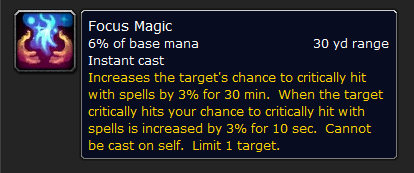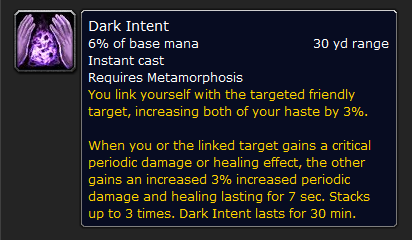One of the burdens that comes along with being a healer is the unenviable task of buff management. Druids have Mark of the Wild and can provide various buffs, depending on the form that they are in. Paladins spent the last two expansions dealing with the constant bickering about which blessing each person in the raid wanted and coordinating that effectively. Priests have Power Word: Fortitude and Shadow Protection. Shamans have a similar responsibility to paladins, in terms of coordinating which shaman will drop what totem and which one doesn’t stack with which existing raid buff and so on. Having people in your raid who are understanding and willing to communicate openly and amicably with you can certainly make this process much easier.
There are also buffs that can be provided to a raid that are not meant for the entire raid to have or to be able to enjoy. Whereas the above mentioned buffs can be distributed pretty evenly to those in need, certain buffs can involve some amount of discussion and even competition for those resources. These buffs can include, but are not limited to Power Infusion, Hysteria and Focus Magic. One of the more highly coveted buffs, Focus Magic is a buff provided by arcane mages and works as follows:

In the past, the arcane tree was the clear choice for raiding mages and any mage worth their salt would carry around a Focus Magic macro, which would show who was going to receive each mage’s buff. Sadly, it usually went a little something like this:
Mage 1 — > Mage 2 — > Mage 3 — > Mage 1
Eventually, things changed and arcane was no longer the clear winner in the DPS race and was replaced by fire. Focus Magic was placed deep enough in the arcane tree where mages would not be able to spec fire and have enough points to reach down into the talent tree to take Focus Magic, too. Despite a few mages clinging tightly to their arcane talents, due to believing the difference in DPS not being enough to completely rule the spec out, Focus Magic soon began to fall out of favor and its presence all but disappeared from raids.
In an attempt to homogenize classes and to ensure that certain buffs were not so class specific, Blizzard gave a similar spell to warlocks this expansion called Dark Intent and it looks a little something like this:

There are a number of immediately noticeable differences between the two abilities:
– Warlocks of all specs have access to Dark Intent, contrary to the tooltip that states Metamorphosis (a Demonology talent) is a pre-requisite.
– Only periodic damage or healing spells will trigger the effect. Direct healing spells or direct damage that crits will not.
– Critical Periodic Damage can come from melee DPS, not just casters.
– The effects of Dark Intent can stack up to 3 times and increases overall periodic damage and healing done, not just the chance to crit.
So, warlocks have an amazing new buff to play with, that seems to appeal to a wider variety of classes and specs in the raid. This undoubtedly brings up a number of questions. Which classes or specs make the best choices to give Dark Intent to? Should warlocks get to choose who they give their buff to? Will Dark Intent really make that much of a difference in performance to make these questions relevant? Let’s find out!
Who Should Get It?
One of my guildies linked a terrific guide found on MMO that shows the results of some theorycrafting that shows who the top choices are to receive Dark Intent. The numbers are broken down, based on a number of criteria. The results are separated based on overall raid DPS gain, depending on which spec the warlock in question is and then based on personal DPS gain. The numbers showing personal DPS gain were not divided up, based on the warlock’s spec, because there was no difference in the results.
Regardless of spec, for both raid and personal DPS gains, shadow priests were the top target for this buff, followed by balance druids, fire mages and feral druids. For raid DPS gains, typically a survival hunter would be your next best bet after that, regardless of the warlock’s spec. For personal DPS gains, a frost mage would be the next best choice, due to their high crit rating and the DoT from Frostfire Bolt. Interestingly, Dark Intent does not work to full capacity, when placed on another warlock. The haste stacks, but the stacked increase to periodic damage and healing does not. The two warlocks in question would receive 6% haste from each other and nothing else. Therefore, they and the raid stand to gain much more from Dark Intent by casting it on someone else.
Since Dark Intent can also increase healing, there are situations where healers may make a better choice for the buff than DPS would. Resto druids are the clear winners here, followed by raid healing holy priests, resto shaman and then tank or single target healing holy priests. Discipline priests and holy paladins were found to be the least favorable healers to receive this buff, due to their minimal usage of heal over time effects (in the case of discipline priests) or the near absence of those effects (in the case of the holy paladins).
Who Gets To Decide?
The usage of Focus Magic was never something that was something that had to be controlled or watched over by an officer or anyone in charge in any guild I have ever been in. Most people would roll their eyes and sigh when they saw mages spam their Focus Magic macro in raid chat and would think nothing more of it. The truth of the matter is that the person giving the buff, be it a mage or a warlock, has a personal stake in who they give Dark Intent to. If they give it to someone who has periodic damage or healing capabilities, but is not geared for or does not have enough crit to support the stacks that come with it, nobody wins. They should have every right to make that call and decide who will give them and the raid the best bang for their buck.
The only time that I feel an officer should intervene is if they see the warlock using poor judgment in who they give Dark Intent to. If you see a holy paladin receiving Dark Intent a half dozen times on a raid night, I would pull the warlock aside and give them a stern talking to. If you see warlocks taking bids on who gets the buff and not considering what is the best thing for themselves or the raid, I would put my foot down on that. Let the warlock use their best judgment, until you realize that maybe they aren’t.
Does It Make A Difference?
You betcha! Taking into account that the theorycrafting was done using Tier 11 BiS gear (iLevel 372), thousands of DPS could be at stake here. Thousands! Affliction warlocks giving Dark Intent to shadow priests led to the highest increase of raid DPS at 4131 DPS, followed by moonkin at 3462 DPS gained. Demonology warlocks posted the next highest increase in raid DPS by giving the buff to a shadow priest. That combination led to an increase of 3270 raid DPS, with moonkin giving an increase of 2598 DPS. Destruction warlocks showed noticeably lower numbers, with the highest raid DPS increase being 3076 DPS, again working in tandem with a shadow priest. Each spec showed the highest personal DPS gain by working with a moonkin and showed an increase of 1999 DPS by doing so.
The bottom line, which has become a motto of sorts for this expansion is “Every little bit helps.” If using Dark Intent at the right time and on the right person is going to increase your chances to kill a boss faster or to heal through something with less stress and mana usage involved, I’m all for it. I would not scoff at the increases you might see right now, just because they may not be as noticeable as the ones shown on the guide that I linked. Encourage your warlocks to do the right thing and encourage those they decide to give Dark Intent to to use it to it’s fullest. Having a buff that require two people to make the most of it only stands to increase the sense of teamwork and camaraderie that your raid as a whole should be experiencing towards each other.
It was always my understanding that warlocks were all about Fear and Corruption. Who would have thought such a class could be responsible for such warm, fuzzy feelings?

